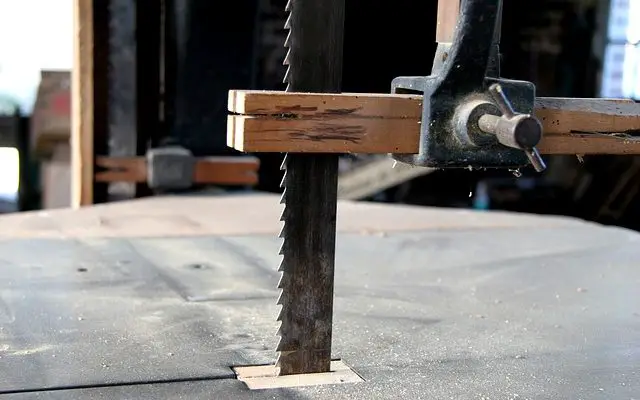Imagine you’re working on a project and you need to rip a thin board in half. After you have your two boards, you will need to cut an intricate design in the top of one of your boards. Typically, you may need to power up multiple saws to help you complete this challenging job. With a bandsaw, you could create this piece with only one piece of machinery.
Bandsaws are considered staple tools in the workshops of woodworkers around the world. They are versatile and strong. Their capabilities help them to be used in a wide variety of projects. They are used in a wide variety of shops including woodworking, metal and fabrication and even butcher shops for meat cutting!
In this article we will explore the function of bandsaws, projects that can be completed with them, and how to choose the right size bandsaw if you do choose to purchase one.
History
Bandsaws were one of the first saws invented. The first patent for a bandsaw was issued in the early 1800’s in England. However, it wasn’t until the mid-1800’s that a reliable version of the saw was developed. Even after 200 years, this saw is one of the first saws that woodworkers will purchase for their shop. (source)
Anatomy of a bandsaw
Bandsaws can come in a couple different sizes; however they all operate the same way. They have two wheels, one above and one below the surface of the cutting table that is used to hold the blade into place.
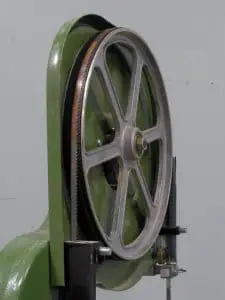
The blade moves in a continuous loop around these two wheels while the tool is cutting. Bandsaws can be set on tabletops or they can be purchased as large steel machines that sit on the floor. Both styles of bandsaw cut the same and deliver the same type of results.
The bandsaw runs with a steady blade. Unlike scroll saws, bandsaws do not have any significant vibrations in the blade while they are cutting. This helps to create smooth details in woodworking projects.
One of the greatest assets of a bandsaw is the fact that a wide range of blades can be installed on it. This will gives greater flexibility in the types of cuts that it can perform.
Many bandsaws can accept blades as small as ⅛ of an inch and up to one inch wide. The smaller the blade is, the tighter if a cut it will be able to perform.
Changing blades is relatively easy as well. It simply requires the user to loosen the tensioner and swap out the cutting blades. When the blade size is changed, the tension of the wheels need to be adjust appropriately to ensure the blade remains in place.
Bandsaws can also come with adjustable speeds and table angle so that they are able to be used for angled or mitered cuts. This gives them an even wider variety of uses and capabilities in the woodworking field.
The versatility of a bandsaw broadens even more by the fact that it is able to cut various types of material. They can cut a wide variety of materials from wood to metal. The only requirement to cut other types of material is to ensure that the proper blade is installed.
What Is A Bandsaw Used For?
Bandsaws are a tool that can be used for many different purposes. In woodworking, they can be used to cut delicate and intricate designs in wood, or they can be used for ripping. Though they typically come after a table saw in a woodworker’s order of tool collection, their versatility gives them the ability to be used as a hobbyist’s first saw if one so chooses.
Intricate Cuts
One of the most common uses for bandsaws are intricate cuts. These cuts can include shapes, curves, or angles. They can be done on any thickness of wood as long as it fits in the saw. Many woodworkers use these intricate cuts to create designs in their pieces while others use them for accuracy is small projects.
Ripping Wood
The second most common use for bandsaws behind intricate designs is typically ripping wood. Ripping is the action of cutting a piece of wood in a straight line parallel to the grain. Bandsaws can be good tools for ripping because they are able to cut wood at a depth that not many other saws would be able to keep up with. However, some smaller bandsaws may not have the power to make ripping an easy action. If you do not have a tablesaw, though, bandsaws are a great way to continue ripping wood as you need to.
What Can I Make With A Bandsaw?
A wide variety of woodworking projects are created each day with bandsaws. One of the most common projects is adding design work to larger pieces. For example, carpenters may use a bandsaw to add detailed trim to a home or piece of furniture.
Many woodworkers use bandsaws to create home decor items. A few items that can be easily created are picture frames, boxes, and detail-rich tables and chairs. Children’s toys such as cars, puzzles, and pull-behind toys can also be made with this tool.
If the woodworker was ripping, they would be able to make shelving, veneer, or cabinetry with a bandsaw. They could rip wood for any type of project they were working on to help their lumber have smooth, straight edges.
Do I Need A Bandsaw?
Bandsaws are not always a necessary tool, but they do add potential to the shop of any woodworker. If you often make intricate cuts and want to do so in deep wood and with smooth motions, you may need a bandsaw.
If you find yourself doing a large amount of ripping and want to have tremendous control over the action, a bandsaw could benefit you as well. If you want to get started in woodworking and do not have a saw, you may want to start with a bandsaw so that you would quickly be able to complete a wide variety of projects.
What Type Of Bandsaw Should I Purchase?
There are two main types of bandsaws, those that sit on workbenches and those that come in a large frame and sit on the floor. Both of these saws have similarities and differences, so it is important to know which one will be the best fit for your needs as a woodworker.
Benchtop Bandsaw
A benchtop bandsaw is great for small spaces. It sits right on a workbench or countertop. However, it is smaller and typically does not have as much horsepower as a floor standing bandsaw. This makes benchtop bandsaws good for two types of people; woodworkers who do mostly hobby work, and woodworkers who have a small workspace.
Benchtop bandsaws typically have between ¾ and 1 horsepower. This is less power than floor standing bandsaws, but it is still plenty of power to do most hobby jobs. They are still capable of cutting wood as thick as the height of their blade allows.
These saws are typically between 12 and 16 inches wide at their table top. They have a set speed, adjustable tables, and can be used for both intricate cuts and ripping wood.
Floor Standing Bandsaw
Floor standing bandsaws are the larger and stronger version of the two. They are typically a good choice for woodworkers who work commercially or who have frequent, large projects to complete. They do require a fairly large space in your shop, so you will need to ensure 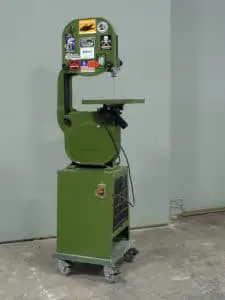 that you have available floor space if you choose to purchase this tool.
that you have available floor space if you choose to purchase this tool.
Floor standing band saws usually have 2 horsepower. This gives the tool enough power to cut frequent jobs and the power to cut large depths. It also gives the tool the ability to have variable speeds, which can be extremely useful in detailed cuts.
One example of a project that would definitely require a floor standing bandsaw is the creation of veneer from a thick log. This job requires repetitive, deep cuts and would not be able to be completed with a smaller saw.
Overall, bandsaws are a versatile tool that can benefit the work of most woodworkers. They work well for intricate cuts and ripping wood. They are commonly used for a variety of projects ranging from household items and children’s toys to veneer and carpentry.
Bandsaw sizes
If you decide to purchase a bandsaw, remember that it is important to first decide what size bandsaw you will need for your projects. Bench top bandsaws are great for small spaces and hobbyists, but they are not as strong as floor standing bandsaws.
The floor standing version of this tool is stronger and larger, and it works well for commercial woodworkers or those who have a high project volume. However, they are large and need a dedicated space on the floor of your shop.
Bandsaws are typically measured in two ways – a number displayed in inches and a number that displays the motor’s horsepower. The number that is displayed in inches is the thickest piece of wood that that particular saw can rip.
Benchtop bandsaws typically have a max cutting depth of around 9-10” (like this one by Skil on Amazon). Floor standing models will have cutting capacities of 12” and up. It’s not uncommon for some commercial grade saws to be able to cut 20” and more.
The often-overlooked feature that you should consider when looking for a bandsaw is the horsepower of the motor. This is will have a significant impact on the type and thickness of wood that you can rip. Most bench top bandsaws will only have a rating of 1/3 hp. It will be near impossible to cut a piece of hardwood that’s 9” thick (max cutting depth of benchtop saws mentioned above) with this size motor.
If you expect to rip thick pieces of hardwoods in the future, I would recommend getting a saw with at least 1 horsepower.
There’s nothing wrong with getting a benchtop bandsaw if you don’t think you’ll need the extra cutting power. The one I linked above by Skil is a great budget machine that will allow you to make great cuts.
Bandsaw vs Scroll saw
If you are like me, when you are beginning to learn woodworking, you started exploring which saw you needed to purchase next. Depending on the type of woodworking you are interested in, one of your first saw purchases will be a scroll saw or bandsaw.
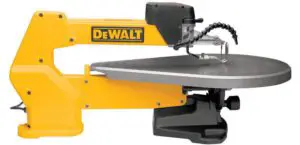 If you are nervous and intimidated by using saws because you don’t have experience using them, a scroll saw is a great one to start out on because injuries are less common and less serious.
If you are nervous and intimidated by using saws because you don’t have experience using them, a scroll saw is a great one to start out on because injuries are less common and less serious.
I learned to cut on a scroll saw in my early teens in my dad’s shop. A scroll saw is going to give you the ability to make cuts in small spaces and make tight turns that you won’t be able to do with a bandsaw.
Another positive for the scroll saw is the ability to cut the centers out of pieces. For instance, let’s say you are cutting the letter “O” out of a piece of wood. To cut the inside of the “O” with a scroll saw, you’ll simply drill a small hole in the middle of the letter. Then you can easily disconnect the blade on your scroll saw and feed it thru the hold you just drilled. Turn on the saw and you are easily cutting out the center of your letter. A bandsaw does not give you that ability because it’s a closed loop blade.
A scroll saw is limited in the thickness of wood that it can cut. The thickest wood that you will be able to cut on a scroll saw is about 2”. Some saws go up to 2.25”. Understand though, just because a scroll saw is limited in how thick it can cut, you can make some amazing pieces with the saw as seen by these design books on Amazon.
A bandsaw is certainly a step up from a scroll saw in both power and ability. As we’ve covered above, it’s going to allow you to rip wood and logs up 12” thick for an entry level machine. It’s also going to allow you to make intricate cuts, but it isn’t as quick as a scroll saw and navigating tight turns.
In my opinion, a bandsaw is one of the most deceptive saws in the shop when it comes to injury. Because of it’s relatively low noise and ease to use, I’ve seen many woodworkers let their guards down when using the saw. This saw can cause serious injuries to your hands if you are not careful.
My advice for someone trying to decide between a scroll saw or bandsaw is this:
Buy a scroll saw if:
- You are nervous and intimidated by using saws and have little to no experience
- You are only interested in make small cuts
- Space is limited
Buy a bandsaw if:
- You do not intend to make small, detailed cuts
- You need to be able to rip large boards or thick logs
- Space isn’t a major concern
If you decide to use a scroll saw and you expect to use it often to make things, I highly recommend this one by Dewalt that you can find on Amazon. It’s an excellent saw that is highly rated. Removing and installing the blade on this machine is very easy which is important when doing scroll work. If you need one that is a bit more budger friendly, I’d go with this Shop Fox version because it’s a great brand and I really like the vacuum and dust control setup on this model.
If you are looking for an entry level floor-standing bandsaw, the one by WEN is very nice. It isn’t going to come with a ton of features, but for the price, it’s a great saw, especially for a floor standing unit. If you are looking for more than an entry level bandsaw, I really like all of Grizzly’s product.
Closing
A bandsaw is a tool that you will use for a large amount of your woodworking projects. There’s a good chance that you will use this saw for many years of your life. It will cut down the number of saws you need to own and use with its versatility, and it will provide you with many cutting opportunities that may not have been possible without it. With such a wide variety of features, bandsaws truly would benefit the work of most woodworkers around the world.
Additional Related Topics
What does a horizontal band saw do? Horizontal bandsaws are not very common in small scale workshops. These saws have much more narrow range of capabilities than their vertical counterparts. These saws are often used specifically to rip wood or to cut large pieces of metal. It’s not possible to get the smaller, more detailed cuts when using one like you can with a vertical saw.
When using a horizontal bandsaw, the material you are cutting remains in place. It gets cut by moving the saw into the material which is the exact opposite than a vertical bandsaw.
Since these saws have very specific tasks and take up a considerable amount of space, they have never become nearly as popular as their counterparts.
What width bandsaw blade is best for resawing? Most blades for resawing are going to be in the ½ to ¾ inch range for resawing. Wider blades can be found, but these are most common. Here’s a link to the resaw blades that Amazon carries.
How long do bandsaw blades last? There’s no set timeframe for the life of bandsaw blades. Typically, the blades that come with a new saw are junk. They generally won’t last long, so I would suggest picking up a separate set of blades when you buy you saw.
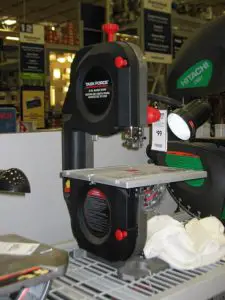
A brand that I have used for years and always been happy with is Timber Wolf. I’ve also found that Amazon carries their blades for the best price. Here’s a link to everything they stock.
When is it time to change blades? The two best indicators that I look for is 1) how quickly is the blade cutting and 2) is it burning the wood. Once a blade starts to wear out, you’ll find that your feed rate will decline significantly. In other words, you won’t be able to push the wood through the blade nearly as quickly due to the dull teeth.
The other thing you will commonly see is that the wood you cut will have black burn marks where they have passed against the hot blade. You may also noticed minor smoking coming from the blade as you are cutting the wood.
How tight should bandsaw blades be? Finding the perfect tension for your blades takes some practice. Setting the blade too tight can cause it to break, while keeping it too lose will cause it to come off track or create crooked lines in the wood you are cutting.
As Fine Woodworking found, the majority of tension adjustment gauges that are built on a saw are inaccurate. There are blade tensioner tools that you can but, but they are very expensive. The article by fine woodworking that I linked above goes into great detail on how to set your blade tension without having to buy any additional tools.
Why is my bandsaw squealing? If you notice that your bandsaw has become considerably louder all of a sudden, the first thing you should check is the blade guides. The guides are in place to keep the blade from moving too far out of place. It’s common for these guides to be over tightened during blade or wheel changes. Then when the saw is turned on the guides begin to pinch the blade which causes friction and usually a loud high-pitched squeak.
Fortunately, it’s very easy to correct this. First off, locate your guides. There are typically two sets. One is located just below the table and the other is just above it. You’ll want to loosen these guides so that you can slide a sheet of paper freely between the blade and guides. Once you have them set, just tighten up the screws that hold them in place and you should be ready to cut.
How loud are bandsaws? In my experience, bandsaws are on of the quieter saws that I have in the shop. Multiple studies have shown that prolonged exposure to noises more than 85 decibels can cause hearing loss.
Noise levels will obviously increase when you are cutting wood over when it’s just running. Another factor that will influence noise levels is the thickness of wood that you are cutting. The thicker the wood, the louder it will become. My older craftsman saw runs around XX decibels when it’s not cutting and increases to XX when cutting a piece of 2×4 pine.
If you are interested in seeing the different options available for hearing protection for woodworkers, take a look at this article I wrote.

